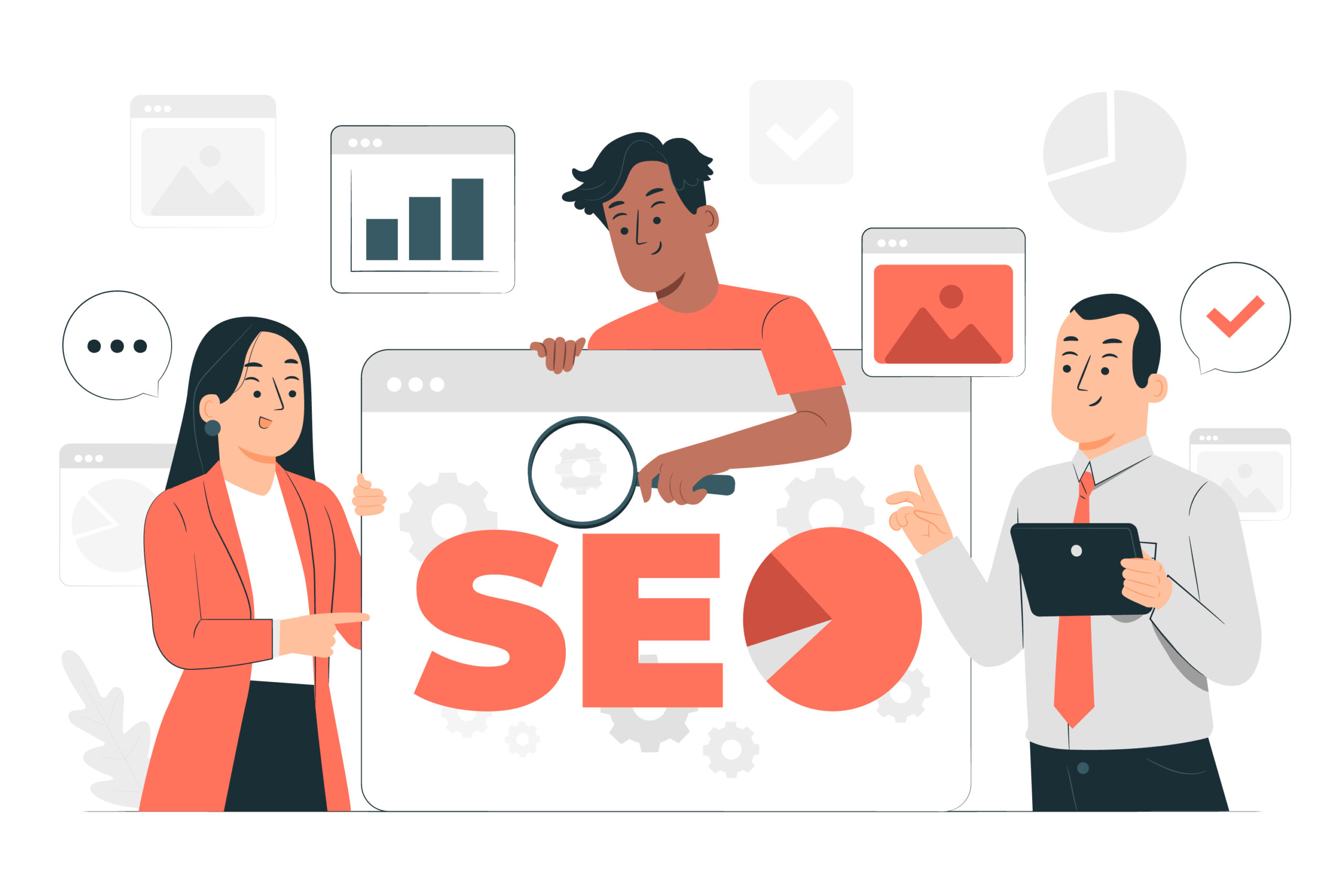Seeking to increase the ranking of a webpage on Google?
In this guide, learn about the best on-page SEO practices that help you rank your website higher on Google.
Here’s the complete on-page SEO checklist:
- Research Potential keywords
- Optimize the title tags
- Effective H1 Tag for Better SEO
- Keyword-Rich Meta Descriptions that increases CTR
- Optimize the URL Structure for SEO-friendliness
- Strategic Keyword Placement to Content
- Valuable Content that is Optimized for user search intent
- Utilizing Header Tags for Enhanced Content Structure
- Implement Internal links to boost SEO
- Add engaging visual content
- Implement schema markup
Bonus:
- Make sure your page is indexed
- Boost your page speed
- Make sure your page is mobile-friendly
-
Research Potential keywords
Identifying the right keywords for your website is like finding the perfect bloom in a garden. It’s essential for attracting the right visitors and growing your online presence. To do this, we can utilize powerful tools like Ahrefs Tool, which acts as our compass in the vast landscape of search queries. The factors you need to consider while selecting the targeted keywords for your business includes:
- Intent: Understanding the underlying purpose or motivation driving each search query.
- Volume: The average monthly search volume for a specific keyword, providing insight into its popularity.
- KD% (Keyword Difficulty): An indicator of the competitiveness associated with ranking for a particular keyword in the top 10 unpaid Google results.
Here’s an example of effective keyword research in practice:
Imagine you run a bakery specializing in artisanal cakes. You might initially think targeting the keyword “chocolate cake” is a sweet idea due to its high search volume of 80,000 searches per month. However, upon further investigation, you discover it has a keyword difficulty of 70%, indicating fierce competition.

Not only that, but when you peek at the search engine results page (SERP), you notice it’s flooded with recipe blogs and cooking tutorials rather than bakery websites. This suggests that most people searching for “chocolate cake” are seeking recipes, not ready-made cakes.
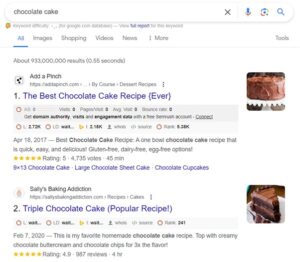
Instead, you might pivot your strategy and set your sights on keywords like “custom birthday cakes” or “special occasion cakes.” While these keywords may have lower search volumes, around 10,000 searches per month, they also boast lower keyword difficulties, making it easier for your bakery to rise in the ranks.
By understanding the intent behind these keywords, which is likely to find a bakery for a special event, you can tailor your website content accordingly. Perhaps you could create a page showcasing your stunning custom cake designs, complete with testimonials from satisfied customers.
-
Optimize the Title Tags
Crafting an effective title tag is crucial for optimizing your webpage’s visibility on search engine results pages (SERPs) and enticing users to click through. Your title tag acts as a concise summary of your page’s content, communicating its relevance to both Google’s algorithms and human users. Here’s how to optimize your title tag for maximum impact:
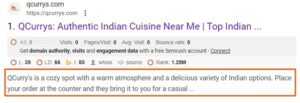
- Primary Keyword Placement: Begin your title tag with your primary keyword, the main search term you aim to rank for. Placing it near the start signals to search engines the topic of your page right away.
- Be Descriptive: Your title tag should accurately reflect the content of your page while being compelling enough to attract clicks. Keep it concise but descriptive, giving users a clear idea of what they can expect upon visiting your page.
- Avoid Keyword Stuffing: While it’s essential to include your primary keyword, avoid stuffing it unnecessarily or repeating it excessively. Aim for a natural incorporation of keywords that reads smoothly and doesn’t appear spammy.
-
Effective H1 Tag for Better SEO
In the realm of on-page SEO, one of the fundamental yet crucial elements is the proper utilization of H1 tags. Unlike title tags, which are visible on search engine results pages (SERPs), H1 tags reside within the page itself, serving as the headline or title.
Creating an effective H1 tag is akin to creating a concise yet compelling summary of your page’s content. While there’s no strict character limit for H1 tags, it’s essential to ensure coherence and relevance. Incorporating your primary keyword naturally into the H1 tag aids both search engines and visitors in understanding the page’s topic.
Pro Tip: Optimize Your H1 Tag for User Engagement
Beyond keyword inclusion, consider optimizing your H1 tag to enhance user engagement. Instead of merely focusing on search engine algorithms, strive to craft a headline that resonates with your audience and entices them to delve deeper into your content.
-
Keyword-Rich Meta Descriptions that increases CTR
Meta descriptions play a crucial role in improving your click-through rates on search engine results pages (SERPs). While they don’t directly influence your rankings, they are vital for attracting users to click on your link. Here’s a unique tip to enhance your meta descriptions:
- Focus on Clarity and Relevance: Your meta description should offer a concise and clear summary of what users can expect from your webpage. Avoid vague language and aim to accurately reflect the content of your page. Be straightforward about the value proposition you’re offering to visitors.
- Incorporate Target Keywords Naturally: Integrate relevant keywords into your meta descriptions in a way that feels organic and seamless. By including primary keywords, you not only signal the topic of your content to search engines but also increase the likelihood of your listing being highlighted when users’ search queries match your keywords.
-
Optimize the URL Structure for SEO-friendliness
In the realm of web design and search engine optimization (SEO), the URL slug plays a crucial role. Essentially, it is the segment of the URL that uniquely identifies a particular page. For instance, in the URL “www.example.com/understanding-url-slugs”, the slug is “understanding-url-slugs”.
Crafting an effective URL slug involves striking a balance between conciseness, clarity, and descriptiveness. It serves as a roadmap for both users and search engines, conveying what the page is about at a glance.
Here are some key pointers to consider when creating a URL slug:
- Incorporate Primary Keywords: Opt for your page’s primary keyword(s) within the URL slug. This not only helps users understand the content but also aids search engines in indexing and ranking your page appropriately.
- Redirect Maintenance: If you ever need to change your URL slug for any reason, ensure that proper redirects are in place to direct traffic from the old URL to the new one. This prevents users from encountering dead links and maintains SEO equity.
-
Strategic Keyword Placement to Content
Google’s algorithms prioritize relevance, making keyword inclusion vital for SEO success. However, strategic placement is key; avoid the pitfall of keyword stuffing, which can harm your rankings.
Tips:
- Prioritize Early Inclusion: Incorporate your primary keyword within the first paragraph of your content. This signals to both users and search engines the focus of your page.
- Strategic Distribution: Disperse repeats of your primary and secondary keywords throughout your content. This reinforces relevance without resorting to unnatural repetition.
- Natural Integration: Ensure keywords blend seamlessly into your content, enhancing readability and user experience. Remember, you’re writing for people, not just algorithms.
- Learn from Competitors: Analyze top-ranking pages to understand effective keyword usage. Identify patterns and techniques that resonate with your target audience.
-
Valuable Content that is Optimized for User Search Intent
Creating content that not only ranks well on search engine results pages (SERPs) but also resonates with your target audience is essential for online success. Here are some tips to ensure your content is both valuable and optimized for user search intent:
- Understanding User Intent: Before diving into content creation, it’s crucial to understand what users are searching for. Are they looking for information, products, services, or solutions to their problems? Tailoring your content to match their intent increases the likelihood of engagement and conversions.
- Addressing Pain Points: Identify the pain points, challenges, or questions your target audience faces within your niche.
Providing Solutions: Offer practical solutions, actionable advice, or valuable insights that address the needs and concerns of your audience. - Visual Content Integration: Supplement your written content with visually appealing elements such as images, infographics, videos, or slideshows.
- Regular Updates: Keep your content fresh and relevant by regularly updating it with new information, statistics, or insights.
- Include a Call to Action: Conclude your story with a clear call to action that encourages your audience to take the next step, whether it’s subscribing to your newsletter, downloading a resource, or making a purchase.
-
Utilizing Header Tags for Enhanced Content Structure
Utilizing header tags effectively can significantly enhance the readability and SEO performance of your content. Research shows that incorporating H2, H3, and H4 tags in your articles can boost engagement by aiding readers in navigating through your text.
Remember, maintain a singular H1 header to denote the primary topic of your content. However, feel free to include multiple instances of H2 through H6 tags as needed, depending on the complexity of your material. These tags operate within a nested hierarchy, providing a clear framework for both users and search engines to follow.
For optimal SEO, consider incorporating relevant secondary keywords into your header tags where appropriate. This not only helps to reinforce the thematic relevance of your content but also enhances its discoverability on search engine results pages.
-
Implement Internal Links to Boost SEO
Internal links play a crucial role in enhancing the navigational experience for both users and search engines on your website. By strategically placing internal links between relevant pages, you not only facilitate seamless navigation but also improve the overall SEO performance of your site.
For instance, if your website focuses on home improvement, you can link from an article about kitchen renovations to related pages such as “cabinet refurbishment” or “countertop materials.” These internal links not only guide users to more detailed information but also help search engine crawlers to understand the hierarchical structure and relevance of your content.
Tips:
- Use Descriptive Anchor Text
- Strategic Placement
- Create a Hierarchical Structure
- Link to Relevant Pages
-
Add Engaging Visual Content
Research indicates that articles featuring a variety of visual content tend to garner greater attention, resulting in increased page views, shares, and backlinks. Therefore, it’s prudent to strategically integrate images and videos into your content where they can enhance comprehension and engagement.
Tips:
- 1. Utilize Varied Visual Formats: Experiment with diverse types of visuals, including infographics, GIFs, animations, and interactive images. Each format offers a unique way to convey information and capture the audience’s interest.
- 2. Optimize Image Attributes: Ensure that every image is accompanied by descriptive alt text. This not only improves accessibility for visually impaired users but also enhances search engine optimization by providing relevant context for your images.
- 3. Prioritize Quality Over Quantity: While incorporating visuals, prioritize quality over quantity. Choose images and videos that are relevant, high-resolution, and visually appealing to maintain the professional aesthetic of your content.
- 4. Craft Engaging Video Content: Produce videos that align with the search intent of your target audience. Whether it’s explanatory tutorials, product demonstrations, or insightful interviews, tailor your video content to address specific user needs and interests.
-
Implement Schema Markup
Schema markup, also known as structured data, is like a secret code that helps search engines understand the content on your website better.
One example of how schema markup can be beneficial is through the use of “Recipe” schema, which helps websites like King Arthur Baking stand out in search engine results pages (SERPs). This schema not only helps Google understand the content of the page but also displays additional information such as ratings, cooking time, and ingredients, giving users a better idea of what the page offers.
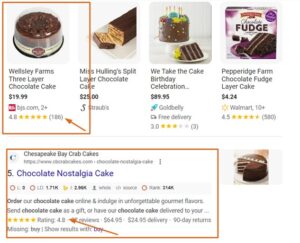
Tips:
- Choose the Right Schema Type: Google supports various types of schema, including Article, Event, FAQ, How-to, Product, and Local Business schema. Selecting the most relevant schema type for your content can enhance its visibility in search results.
- Be Accurate and Detailed: When adding schema markup to your website, ensure that the information provided is accurate and detailed. This includes providing specific details such as product descriptions, event dates, or cooking instructions for recipes.
- Test Your Markup: After implementing schema markup, use Google’s Structured Data Testing Tool to ensure that it’s properly implemented and recognized by search engines. This tool will identify any errors or issues with your markup that need to be addressed.
Bonus Guide: Work on Your Website’s Technical SEO
-
Make sure your Page is Indexed
Before your web page can start appearing in search results, it needs to be indexed by Google’s web crawlers. This process involves Google adding your page to its index, essentially cataloging it for future search queries.
To verify if your page is indexed, you can utilize Google Search Console. If you’re new to this tool, don’t worry; there’s a guide available to help you navigate through the setup process.
Simply input your page’s URL into the search bar within Google Search Console and inspect the provided information. If your URL isn’t indexed yet, there are steps you can take to address this.
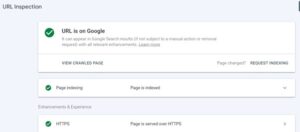
Tips:
- Create a Sitemap: A sitemap is like a roadmap for search engines, helping them discover and index all the pages on your site. Make sure you have a sitemap.xml file uploaded to your website, and submit it to Google Search Console.
- Internal Linking: Ensure that your page is linked to from other pages within your website. Internal links help search engines discover new pages and understand the structure of your site better.
- Robots.txt File: Check your website’s robots.txt file to ensure that there are no restrictions preventing search engines from crawling and indexing your page.
- Quality Content: Produce high-quality, relevant content regularly. Fresh content often gets indexed faster by search engines.
-
Boost your Page Speed
Improving your page speed is crucial for keeping visitors engaged and satisfied. Even a slight delay can cause users to abandon your page and look elsewhere. Here are some common factors that could be slowing down your website:
- Excessive HTML: Having too much HTML code on your page can bog down loading times.
- Redirect Chains: Redirects can add extra HTTP requests and increase loading times.
- Large JavaScript or CSS Files: Heavy JavaScript and CSS files can take longer to load, especially on slower internet connections.
To check your page speed, use Google’s PageSpeed Insights tool. Simply enter your page’s URL and analyze the results. Pay attention to the “Core Web Vitals Assessment” for both mobile and desktop versions of your site. These key speed metrics include:

- Largest Contentful Paint (LCP): This measures the time it takes for the main content of your page to appear. Faster LCP times indicate better user experience.
- First Input Delay (FID): FID measures the responsiveness of your page to user interactions. Minimizing FID ensures that users can interact with your site without delays.
- Cumulative Layout Shift (CLS): CLS quantifies any unexpected layout shifts that occur during page loading. A low CLS score means a more stable and user-friendly experience
-
Make sure your Page is Mobile-Friendly
Ensuring your website is optimized for mobile devices is crucial in today’s digital landscape. With over 60% of Google searches originating from mobile devices, neglecting mobile SEO could mean missing out on significant traffic and potential customers. Google prioritizes the mobile version of your website when determining its quality and rankings, making mobile-friendliness a top priority.
To evaluate the mobile user experience of your website, you can utilize Google’s Lighthouse extension. Simply install the Lighthouse extension from the Chrome Web Store using this link: Lighthouse Extension.

Once installed, navigate to your website on Google Chrome and click on the Lighthouse extension icon in your browser toolbar. Then, select “Generate report” to receive insights into your website’s mobile performance.
Improving mobile-friendliness may not be an overnight task, unlike some other on-page SEO optimizations. However, investing time and effort into enhancing your website’s mobile experience is typically well worth it in the long run.
Partner with Web Arc Media for Expert On-Page SEO Optimization
At Web Arc Media, we take pride in being the leading provider of SEO services in Massachusetts, offering unparalleled expertise and proven results to businesses across diverse industries. Our comprehensive approach to on-page SEO optimization ensures that your website not only ranks higher in search engine results but also delivers a superior user experience, driving conversions and maximizing ROI.
Here’s why partnering with Web Arc Media for on-page SEO optimization is your ultimate guide to success in 2024:
- Customized Strategy: We understand that every business is unique, which is why we tailor our on-page SEO strategies to align with your brand identity, target audience, and business objectives.
- Technical Excellence: In addition to optimizing content, our experts meticulously audit and optimize various technical aspects of your website, including site speed, mobile responsiveness, schema markup, and internal linking structure.
- Content Optimization: High-quality content is the cornerstone of effective on-page SEO optimization. Our content specialists work closely with you to create engaging, informative, and keyword-rich content that resonates with your target audience and drives organic traffic to your website.
- Continuous Monitoring and Optimization: SEO is an ongoing process, and staying ahead of the competition requires continuous monitoring and optimization. At Web Arc Media, we leverage advanced analytics tools and industry-leading practices to monitor your website’s performance, identify emerging trends, and fine-tune our strategies accordingly.
- Transparent Reporting: We believe in transparency and accountability, which is why we provide detailed reports and insights on the performance of your on-page SEO campaigns. Our intuitive dashboards and regular communication ensure that you’re always informed about the progress of your SEO initiatives and the impact on your business objectives.
Wrapping Up
Ready to take your on-page SEO efforts to the next level and unlock new opportunities for growth? Contact us today to partner with industry-leading experts who are dedicated to driving your success in 2024 and beyond. Reach out to us now to schedule a consultation and discover how our tailored solutions can transform your online presence. Let’s elevate your website’s visibility, drive meaningful results, and propel your business towards unparalleled success together.

